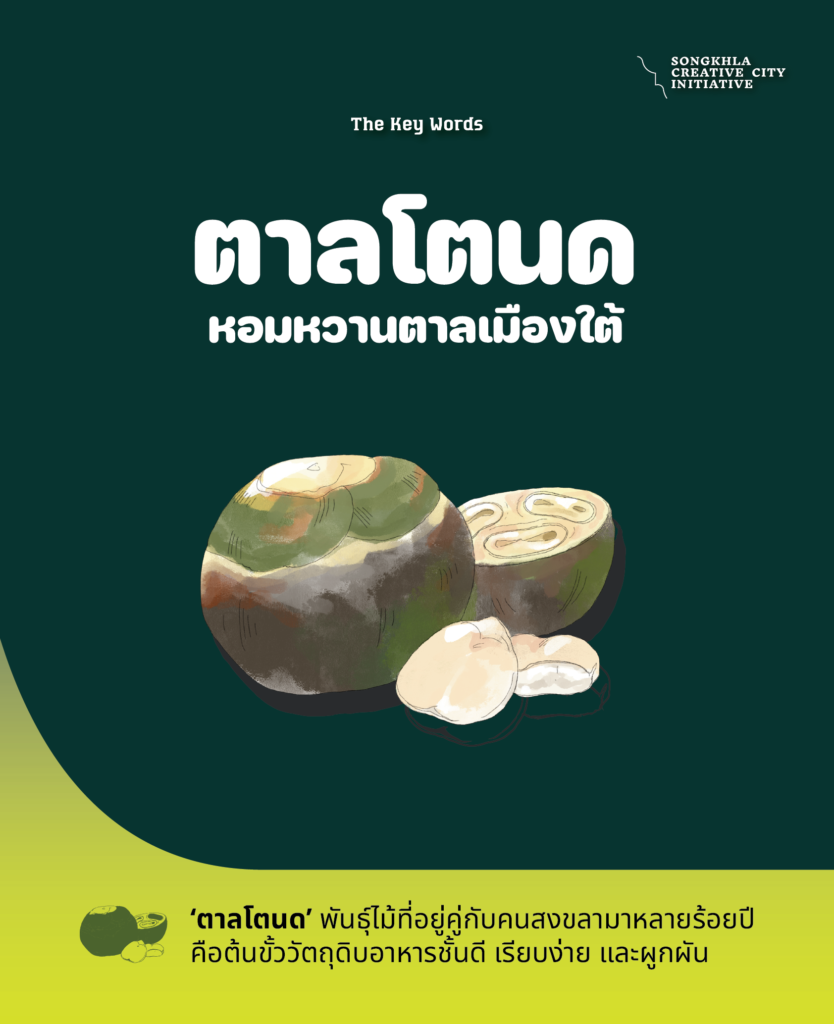“Tal” is a tree that has been with the people of Southeast Asia for a long time. Historical evidence has been discovered dating as far back as the Dvaravati period in the ancient city of Chan Sen (located in modern day Chan Sen Sub-district, Takhli District, Nakhon Sawan Province), consisting of a clay seal featuring a pattern of figures climbing palm trees, dated to the 11-13th century Buddhist era. It is assumed to be the seal of a family responsible for managing production of palm trees in the area for state authorities at that time. In addition, other evidence includes various records and literary works with mention of palm trees as an important local plant, both in the central region, such as in Petchaburi Province and Suphan Buri Province, and southern region, including Sathing Phra Peninsula and Songkhla Province.

Origin of “Tal” – the palm is a type of tree in the same family as coconut, but longer-lived. Some sources claim that “tal” originates from southern India, based on the Hindi word “tal” adopted by Thais. Other sources claim origination from the African continent, with subsequent spreading via historical trade connections between prominent port cities, which may have included Sathing Phra Peninsula. At present, surveys have recorded around 20 palm trees per 1 rai of rice fields in Sathing Phra District, for a total of as many as 500,000 palm trees across the entire district.
The primary outstanding feature of the sugar palm is its ease of cultivation, able to grow in almost any type of soil, with high tolerance to drought, requiring little water, due to deep roots, resistance to strong winds, and long lifespan of up to 100 years. When fully grown, they can reach 30 meters in height, do not create any negative effects on farmland or yield, can be used as shade for raising animals or to mark property boundaries, and provide suitable habitation for birds and bats which can be beneficial for insect pest control, while the droppings provide additional fertilizer for fields.
___
Three main types of sugar palm are commonly grown in the Sathing Phra area: (1) Ka variety – with the distinct characteristics of large, oval-shaped fruit with black skin and cracked edges, popular among villagers and found in larger open areas; (2) Khao variety – with round, plump fruit featuring smooth and shiny yellowish-brown skin, and a sweeter, creamier taste than other varieties, making it popular for use in desserts, while young fruit (sugar palm head) can be used in a variety of dishes, such as salads, curries, stir-fries, and boiled recipes; (3) Khamin variety – a less common cultivar similar in appearance to the Khao variety, but with the bottom of the fruit bright yellow in color, similar to that of turmeric, as well as the fibrous interior flesh, also bright yellow when fully ripe, making them suitable for juicing to produce food coloring.
In fact, possible products from the sugar palm are diverse and can be made from every part of the tree, such as sugar from the inflorescence, which can be consumed as a fresh liquid or further processed into palm sugar, granulated sugar, crystallized sugar, or powdered sugar, depending on the method. The liquid can also be fermented into a unique tasting vinegar, while young fruits (sugar palm head) can be used in cooking. Fully ripe sugar palm fruit can be juiced to produce coloring, while the seeds contained within are sweet and refreshing in taste, making them suitable additions to syrup or useful for desserts. Sprouted sugar palm seeds contain sugar palm pulp which can be used to make confectionaries, such as candied sugar palm pulp, or added to sour curry. Dried sugar palm leaves are strong and durable, able to be used for thatched roofs and are popularly used to make palm fans. Fibers from the leaves and trees can be used to make rope, brushes and brooms, among other items.
It is thus possible to say with full conviction – ‘the sugar palm tree, a true multi-purpose resource’.